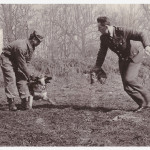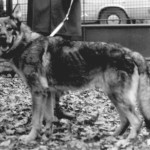The Československý Vlčák, a wolf dog created during the Cold War to monitor the borders of communist Czechoslovakia, today is a race which triggers the “wolf craze” of dog lovers
Forget the fierce wolf of the woods, the iconic villain of fairy tales. The Czechoslovakian Wolfdog (Československý Vlčák, or more briefly CsV) is a specimen “in body shape, movement, coat colour and mask similar to the wolf”, regarding the standard features, but it is actually a dog. A dog from which Red Riding Hood should not stay away from, but rather a four-legged friend, with a strong sense of protection towards the puppies in its family.
All this can be confirmed by Danilo Manghi, an Italian businessman in Prague and a great dog lover, who has become a genuine enthusiast of the race in recent years. Specifically since he adopted Achilles an multi-award-winning specimen, “a friend who completely adapted to my family and children, and to living in the apartment and to following me to the office, to attend public places and restaurants without creating any problem”.
 The lupine look, however, reveals the origins of the race, born in the 50s, in the middle of the Cold War, as a result of an experiment by Karel Hartl, Colonel of the Border Guard of the Czechoslovak Army, who tried to cross the German shepherd with the Carpathian wolf. The original purpose was not to create a new race but to check whether crossbreeding with wolves could improve health, tenacity and endurance of dogs, while maintaining their aptitude for military duty. Hartl, in charge of cynology, began his genetic experiment at the station of Libějovice, where there was a centre of research dedicated to improving methods of military dog training.
The lupine look, however, reveals the origins of the race, born in the 50s, in the middle of the Cold War, as a result of an experiment by Karel Hartl, Colonel of the Border Guard of the Czechoslovak Army, who tried to cross the German shepherd with the Carpathian wolf. The original purpose was not to create a new race but to check whether crossbreeding with wolves could improve health, tenacity and endurance of dogs, while maintaining their aptitude for military duty. Hartl, in charge of cynology, began his genetic experiment at the station of Libějovice, where there was a centre of research dedicated to improving methods of military dog training.
After an initial failure, the breeding of the wolf Brita with the German Shepherd was a success and in May 1958 the first puppies were born, which were three-quarters wolf. They had inherited both the physique and the behavior of wolves: very wary, ready to flee at the slightest sign of danger and with a strong attachment to the pack. They were very difficult to train, an unacceptable condition for working dogs. The percentage of “wolf blood” diminished in each generation. The fourth, with 6.25%, displayed the genetic requirements hoped for and was ready for use in the Police. When compared to dogs, hybrids showed the best sense of direction and tolerance to cold and fatigue, perfect sight even at night, more refined hearing and smell, which enabled them to excel in tracking down prey. Their task was not to attack or kill intruders but just to detect trail and follow it.
However, the attempt to integrate them into the border units did not go well. Being too faithful to their owners, they resented the frequent changes in their masters and were not aggressive enough, as is required of police dogs.
In 1964 Hartl published the results of research, while already pondering the next step, the recognition of the new breed. Two years later he first wrote about the standard features which the Union of Czechoslovak farmers rejected due to the low number of wolf dogs. There were about a hundred and almost all of them were at the breeding stations at the Border Guard. In 1968 he created another line of hybrids at the military breeding farm of Býchory. Lord was also born here, the wolf of Arabela, a TV series which thrilled Czechs in the ’80s with events taking place half in the real world and half in a fairy tale environment.
At the time of normalization, when the purges also hit the defenders of the borders, it was decided to save the experiment and the gene pool of the breed by transferring many dogs to the Slovakian breeding farm of Malacky, far from the Iron Curtain. If the selection in Libějovice was based on military trainability, in Malacky Major František Rosík, who had long worked with Hartl on the cross-breeding program, tried to standardize the breed from a morphological point of view.
In 1982 the national recognition of species finally arrived and the brood were registered in studbooks as the Czechoslovakian wolfdog. In the same year the Club of the CsV breeders was also founded in Brno. Rosík was named president and Hartl chief adviser. In 1989 the FCI ratified the existence of the species for an initial trial period. The final recognition of the pure breed was confirmed in 1999, in Mexico City, but the genus was already recorded in 1994. As birthplace of the CsV Czechoslovakia was indicated, but the protection of the breed was entrusted to Slovakia alone.
Today the farm is completely run by civil organizations and private owners and this specimen, originally for military purposes, is used as a dog sports or shows. Agile and elegant, it has earned credit for the performances for titles of dog grooming contests ever since the World Dog Show in Brno in 1990. It competes in work and agility tests or in sled dog racing, and is doing very well in the utility and defence tests though its specialty is on tracks. Following trails involves an innate talent, since the training calls for new and always more difficult tracks and the exercises are not repetitive, and are even better when they end with the prize of a snack. It is particularly suited to research, in Italy certain specimens are reported to be working in Civil Defence and Mountain Rescue, along with the Italian wolf. In the Czech Republic the private security agencies have been known to employ them, one has also been used as a guard at the Temelín nuclear power plant. Finally, the CsV has replaced the Siberian husky as the main actor used to represent wolves in films and commercials.
Lately the popularity of the Czechoslovakian wolfdog has grown also abroad, so much so that Italians are now among the leading breeders. If in the Czech Republic there are about 150 births per year, and in Slovakia only a third, in the Belpaese the diffusion is growing dramatically. In 2004, 336 puppies were registered in the studbooks of the ENCI, yet this rose to 1,024 in 2013.
So why do so many Italians choose a CsV? “Certainly the physical appearance does not go unnoticed and the idea of having a dog at home with the charm and the resemblance of a wolf attracts many people”, Manghi explains. “Often the magic ends as soon as the new owners realize that the puppy has a strong and dominant character that requires lots of attention and training with the result that today in Italy the number of abandoned CsVs has become a big problem”. The breeders have confirmed that although unknown until recently, Czechoslovakian wolves are the subject of a worrying “lupine craze” but if they end up in the wrong hands, they can become aggressive and cause serious damage, given their size and the speed of their reaction. The consequences are also serious for the four-legged animals, who climb in the rankings of the most abandoned purebred dogs, and those at the highest risk of euthanasia.
Being an ancestor of the wolf, it has inherited a strong predatory instinct, and is always alert and wary. A pack animal, it therefore does not appreciate solitude which it interprets as abandonment and always seeks attention from family members. “When we walk in the street, it is always close to children”, tells Manghi, “and if by chance one of us walks away, he began to cry and tries to bring us back to the group”. Taking him for a walk, letting him get to know the crowded city and socialize with people and other dogs, are the key to a specific education that first the farmer and then the owner must give the puppy. This requires well-defined rules and hierarchies, but also a both patient and determined master, in which you can recognize a reliable example, its “human pack leader”. A master aware of having made a demanding choice and who does not allow himself only to get captivated by the intense, penetrating gaze of the predatory ancestor.
by Sabrina Salomoni








